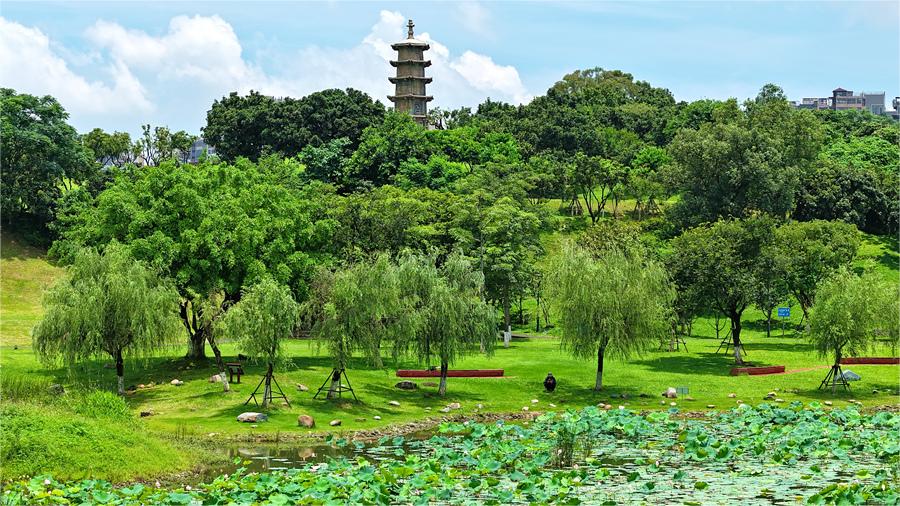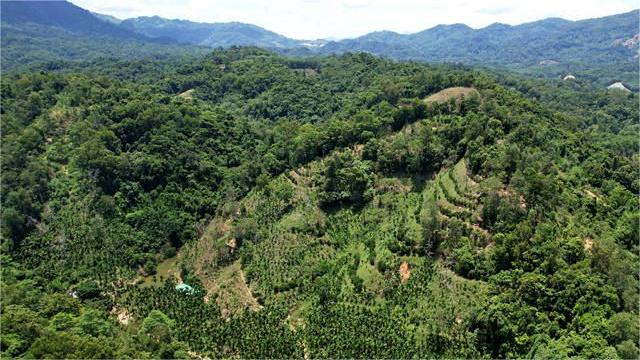"Science and technology backyards" propel rural revitalization in NE China's Jilin
"This is the first rice-fishing farming science and technology backyard (STB) in China," said Wang Qiuju, a supervisor of a master's degree program at Jilin Agricultural University in northeast China's Jilin Province.
Wang is also the chief expert of the Gongzhuling rice-fishing farming STB in Nanwaizi village, Gongzhuling city, Jilin Province. In 2022, the STB was honored by the China Rural Special Technology Association.
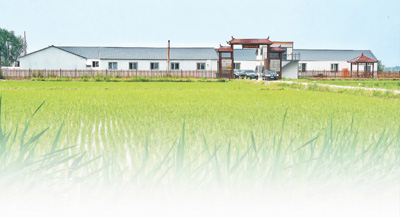
Photo shows the Gongzhuling rice-fishing farming science and technology backyard in Gongzhuling city, northeast China's Jilin Province. (People's Daily Online/Li Yang)
The province boasts of 105 nationally recognized STBs, ranking first in the country, said Chen Yaohui, vice chairman of the Jilin provincial science and technology association.
These STBs are contributing to all-round rural revitalization in the province.
"Under harsh conditions, our university's teachers and students addressed agricultural 'bottleneck' issues faced by farmers," said Zhang Dianfeng, Party head of Jilin Agricultural University, in front of the former site of the Gongzhuling rice-fishing farming STB.
In the summer of 2023, Wang, her husband Wu Min, who is also a teacher from the university, and their postgraduates moved to the new site of the STB with better conditions about 100 meters away from the former site.
The new STB boasts improved research conditions, Wang said, adding that an experimental field, which is the "main battlefield" of her team, is just at the doorstep of the STB.
In 2018, Wang and her team arrived in Nanwaizi village to develop techniques for cultivating crayfish and crabs in rice fields. Farming crayfish or crabs in rice fields helps farmers boost their income and can be economically beneficial, according to Wang.
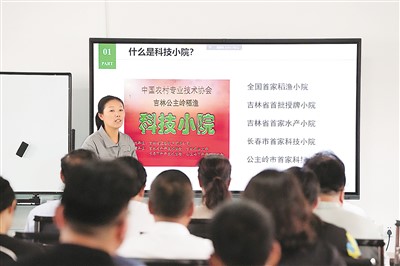
Wang Qiuju gives a lesson at the Gongzhuling rice-fishing farming science and technology backyard in Gongzhuling city, northeast China's Jilin Province. (People's Daily Online/Li Yang)
Every year, just before the start of the rice planting season, Wang and her husband would lead their students to the village and stay for more than half a year.
Zhao Chunyu, a farmer in the village, provided land for Wang and other researchers from Jilin Agricultural University for experiments, becoming the first to "take the plunge" in the village.
At first, local residents were skeptical of Wang's team, as they hadn't seen any tangible benefits. Zhao was initially apprehensive, too. "After all, we've been farming for so many years, but no one had ever tried raising crabs in rice fields before," Zhao recalled.
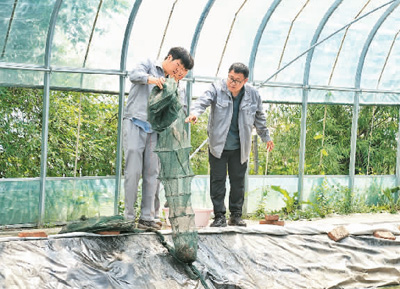
Wu Min (right), Wang Qiuju's husband, checks on the growth of crayfish together with students. (People's Daily Online/Li Yang)
In 2020, Zhao and other members of an aquaculture farmers' cooperative volunteered to feed the crabs, as Wang was pregnant. That year, their collective efforts paid off, resulting in a bumper harvest of both rice and crabs for the cooperative.
One year later, the Jilin provincial science and technology association and Jilin Agricultural University took the lead in establishing the Gongzhuling rice-fishing farming STB in Nanwaizi village. It became one of the first eight STBs recognized by the province, and Wang served as the chief expert of the STB.
The success didn't come easily. After years of experimentation, Wang and her team successfully developed a model for rice cultivation combined with crayfish and crab farming. They devised a technique that significantly improved the survival rate of baby crayfish in Jilin Province and developed special feed for crabs in paddy fields. Thanks to the tailored feed, a crab in paddy fields can now grow to around 100 grams, a significant increase from about 50 grams in the past.
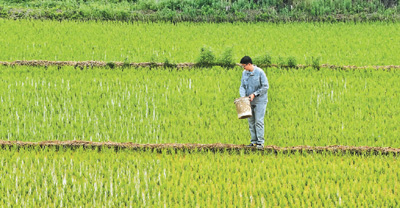
A staff member of the Gongzhuling rice-fishing farming science and technology backyard works in a rice field. (People's Daily Online/Li Yang)
The new model also increases the yield of rice. In 2023, the rice yield of experimental fields exceeded 550 kilograms per mu (667 square meters).
According to Zhao, rice would sell for 5.2 yuan ($0.72) to 5.4 yuan per kilogram previously, but now it can be sold for 10 yuan per kilogram, as rice-crab farming reduces the use of pesticides and fertilizers and leads to better rice quality. Meanwhile, the yield of crabs in each mu of rice field reaches about 15 kilograms. The mixed rice-crab farming increases profits by 300 yuan to 500 yuan per mu.
The STB's innovative farming model has attracted more and more households. The cooperative's experimental fields have increased from 10 mu to over 500 mu, and Zhao has become the head of the cooperative.
The Gongzhuling rice-fishing farming STB, deeply rooted in the countryside, not only promotes technological innovation but also contributes to academic advancement.
Jilin Agricultural University requires postgraduates of the STB to stay there for no less than 120 days per year for research, while supervisors and experts guide the students' research work both online and offline and engage in technique development, field guidance, and the promotion of techniques, Zhang said.
In the past five years, a total of 13 papers from teachers and students associated with the STB have been included in the Science Citation Index (SCI). The STB has helped the cooperative register three trademarks.
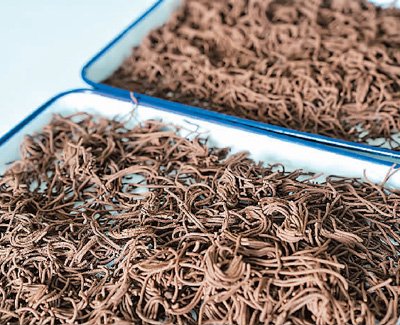
Photo shows feed for crayfish developed by the Gongzhuling rice-fishing farming science and technology backyard. (People's Daily Online/Li Yang)
To extend the STB's reach, Wang created an account on Douyin, a popular short video app platform in China, and often shared videos about baby crayfish bred by the STB, which attracted people who want to buy them across Jilin Province. Wang decided to offer baby crayfish to villagers in many places in the province free of charge.
On June 7, the Jilin provincial crayfish farming promotion conference and popularization day for mixed rice-fishing farming was held at a crayfish farming base in Yitong Manchu Autonomous County, Siping city of Jilin Province. In late May, the industry-education-research demonstration base of Jilin Agricultural University was set up, marking the formal settlement of the province's first and largest breeding base for baby crayfish in cold climates in the county.
These achievements are partly attributed to students from the STB, who have promoted the research results of the STB over the past years, Wang said.
Wang is not alone in implementing the STB program. Wang's husband is the chief expert of the other STB. Jilin Agricultural University's teams run 67 of 105 STBs in Jilin Province.
In recent years, postgraduates of these STBs have applied for 21 patents, published 110 academic articles, held 54 science popularization events, provided technological services for 535,240 mu of land, and promoted 28 new techniques, according to Zhang.
For years, Jilin Province has regarded the establishment of STBs as a crucial measure to accelerate agricultural modernization and promote comprehensive rural revitalization.
The STB program has not only cultivated young researchers but also a large number of "new farmers." As of April 2024, STBs in the province had provided 761 training sessions on agricultural technologies both online and offline, and posted 485 science popularization articles and short videos, benefiting over 30,000 households.
Photos
Related Stories
- AI transforms poultry farming in China's mountainous village
- NE China's Jilin promotes mixed rice-crayfish farming to boost farmers' incomes
- Pic story: female operator aids villagers with combine harvester
- Farmers transplant rice seedlings in Suichuan, E China's Jiangxi
- Farmers plant potatoes in N China's Hebei
- Spring farming in full swing during Grain Rain
- Innovative farming fuels efficiency for 'new farmers' in E China's Jiangxi
Copyright © 2024 People's Daily Online. All Rights Reserved.







